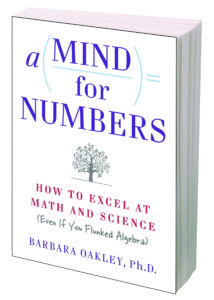I took an online course by Barbara Oakley called Learning How to Learn. I learned so much from the course that I read her book A Mind for Numbers: How to Excel at Math and Science (Even if You Flunked Algebra).
I think the substile minimizes the scope of the book. Oakley talks about learning strategies in general, only occasionally specifying math and science. This book is not only for those who want to learn math and science. It is for anyone who wants to find the best strategies for learning.
Here are some of Oakley’s points on how to learn best.
Use focused mode and diffuse mode
There are two modes of thinking: focused mode and diffuse mode. Focused mode is when you are concentrating. Diffuse mode is when you let your mind wander – taking a shower, jogging, dishwashing. A lot of people think that studying is all about focused mode, but Oakley teaches how to use both.
These two modes of thinking switch back and forth and can’t happen at the same time. Both can be accessed easily. Oakley illustrates this with an anecdote about Thomas Edison. When he was stuck after concentrating on a difficult problem, he would take a nap sitting in his chair holding a ball bearing in his hand. He would relax his mind and enter his diffuse mode. When he fell asleep, the ball would drop. Edison would wake up with a fresh mind. He could work on the problem with new approaches.
Create effective chunks
A chunk is a file of information that your mind can easily access. As you learn more about a subject, the file will be bigger and more useful. It helps you organize random information into pieces that make sense. At the same time, each bit of information remains connected to many other chunks.
As you learn more things, your chunk will getting bigger and clearer. For example, when the first time you hear about Indonesia, your chunk on Indonesia is probably just a small piece – just a map. When you visit Indonesia, you know more about Indonesia and your chunk will expand to the province, culture, food. You form a good chunk by repeated practice in different context. In each new contexts, the chunk is connected to different other chunks. When you study randomly and do not have enough practice, you form disconnected chunks that do not fits with other chunks.
Another example of chunking is when learning to ride a bike. At first, you have to focus on one task at the time – pedaling, steering, and braking, and so forth. After a while, you ride a bike without having to think about each individual movement. Riding a bike has become one big chunk.
Prevent Procrastination
Procrastination is the biggest enemy of success because it prevents you from accomplishing your goals.
Oakley suggests that we procrastinate in order to avoid thinking about the task – say, washing dishes. The thought of washing the dishes is unpleasant, so we tell ourselves that we will do it later, and we find something else to think about. If we overcome the procrastination, we find that the reality of washing the dishes is not as unpleasant as the anticipation.
In order to overcome procrastination, Oakley recommends the Promodoro technique. First, get rid of any distraction – phone, tv, friends. Then set a timer for 25 minutes. Focus your task for that period of time. After successfully completing your 25-minute focus state, take a break and go into diffuse mode. Give yourself a reward. The reward can be as simple as opening your favorite website for 5 minutes. Repeat the technique for other tasks. This helps you form a habit of alternating productively between focus and diffuse modes. Forming a habit of consciously turning on focus mode will prevent procrastination.
In addition to detailed explanation on how to learn, Oakley also describe how not to learn:
Conclusion
Barbara Oakley’s A Mind for Numbers: How to Excel at Math and Science (Even if You Flunked Algebra) effectively translates complexes psychological research and ideas into easy-to-understand English and useful metaphors. She provides many useful resources. This book gives me new insights as well as confirming what I already know about how to learn best. As a teacher, I use Oakley’s approaches to help my students maximize their learning experience. I highly recommend this book for anybody who wants to know the most effective way of learning anything.
This article was published in the Jakarta Post. Please click here to see the complete article.

